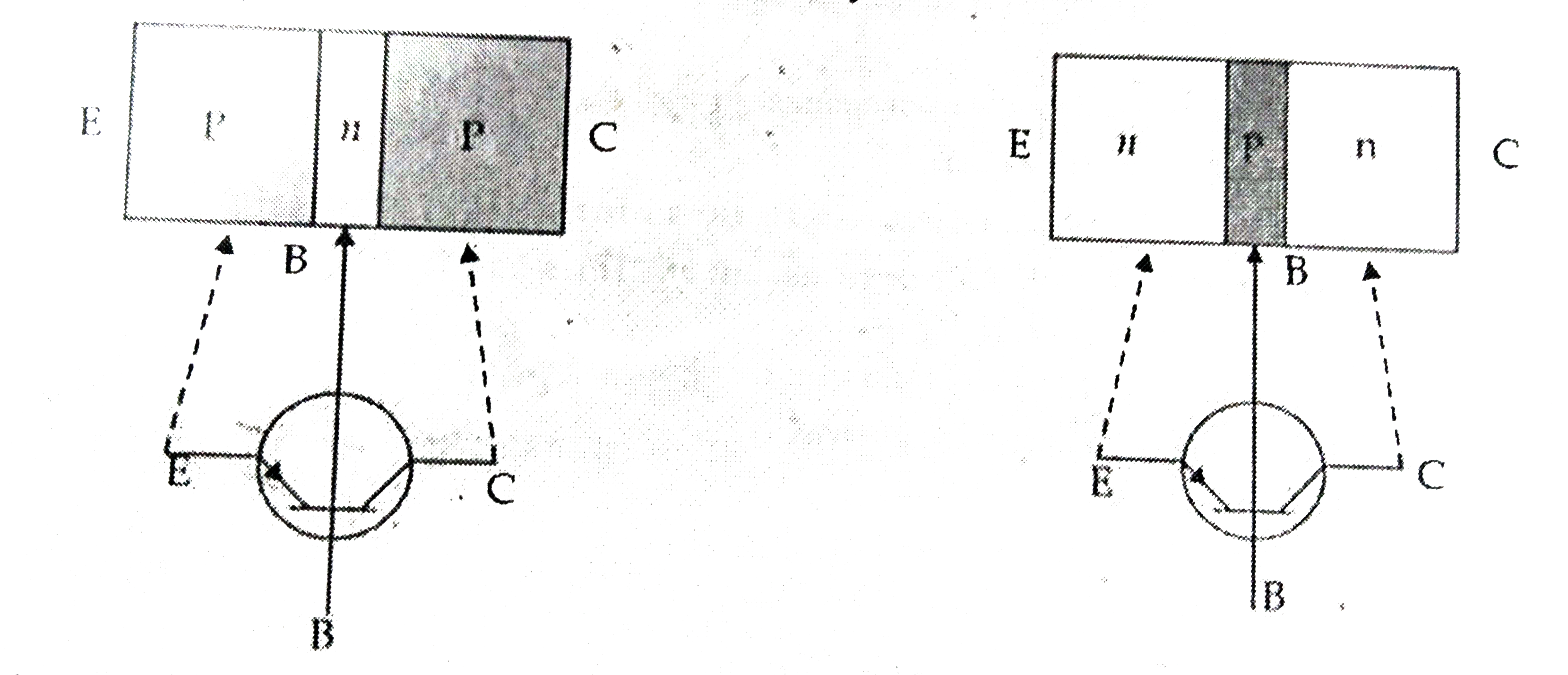(a) Differentiate between three segments of a transistor on the basis of their size and level of dopping.
(b) How is a transistor biased to be in active state?
(c) With the help of necessary circuit diagram, describe briefly how n-p-n trnasistor in Ce configuration amplifies a small sinusoidal input voltage. Write the expression for the ac current gain.
(a) Emitter (E) : It is the left hand side thick layer of the transistor, which is heavily doped.

Base (B) : It is the central thin layer of the transistor, which is lightly doped.
Collector (C) - It is the right hand side thick layer of the transistor, which is moderately dope.
(b) There are two conditions for a transistor to be into an active region.
1. The input circuit should be forwed biased by using a low voltage battery.
2. The output circuit should be reverse biased by using a high voltage battery.
(c) C.E. configuration (Transistor as an Amplifier). The current diagram of a common emitter amplifier using n-p-n transistor is shown in Figure.

The input (base-emitter) circuit is forwed biased and the output (collector-emiiter) circuit is reverse blased.
When no a.c. signal is applied, the potential difference VCC between the collector and emitter is given by
VCC=VCB+ICRC.
When an a.c. signal is fed to the input circuit, the forward bias increases during the positive half cycle of the input. This results in increases in IC and decrease in VCC. Thus, during positive half cycle of the input, the collector becomes less positive.
During the negative half cycle of the input, the forward bias is decreased resulting in decrease in IE and hence IC. Thus VCC would increase making the collector more positive. Hence in a common-emitter amplifier, the output voltage is 180∘ out of phase with the input voltage.
(i) Input signal voltage Vi=IBRB.
(ii) Output signal voltage V0=ICRC.
(iii) Voltage gain (AV) of the amplifier is
AV=V0Vi=ICRCIVRB=β(RCRB)...[∵β=ICIB]
Topper's Solved these Questions
- XII BOARDSBOOK - XII BOARDS PREVIOUS YEARCHAPTER - XII BOARDSEXERCISE - [SET - II DELHI BOARD]
6 Videos
- XII BOARDSBOOK - XII BOARDS PREVIOUS YEARCHAPTER - XII BOARDSEXERCISE - [SET - III, DELHI BOARD]
6 Videos
- XII BOARDSBOOK - XII BOARDS PREVIOUS YEARCHAPTER - XII BOARDSEXERCISE - SET - III (Delhi Board)
8 Videos
- SAMPLE PAPER 2019BOOK - XII BOARDS PREVIOUS YEARCHAPTER - SAMPLE PAPER 2019EXERCISE - SECTION D
6 Videos
Similar Questions
(a) Differentiate between three segments of a transistor on the basis of their size and level of doping.
(b) How is a transistor biased to be in active state?
(c) With the help of a necessary circuit diagram, describe briefly how n-p-n transistor in CE configuration amplifies a small sinusoidal input voltage. Write the expression for the ac current gain.
View SolutionGive a circuit diagram of a common emitter amplifier using an n-p-n transistor. Draw the input and output wavefroms of the signal. Write the expression for its voltage gain.
View SolutionDraw a labelled circuit diagram of n - p - n germanium transistor in common emitter configuration. Explain briefly, how this transistor is used as a voltage amplifier.
View SolutionDraw a circuit diagram to study characteristics of n-p-n transistor in CE configuration. Draw the sketch of input and output characteristics of this configuration . Define current amplification factor ?
View SolutionDraw a circuit diagram of C.E. transistor amplifier. Briefly explain its working and write the expression for (i) current gain (ii) voltage gain of the amplifier.
View SolutionDraw a labelled circuit diagram of a common base amplifier using a p-n-p transistor. Define the term voltage gain and write an expression for it.
View SolutionWith the help of a labelled circuit diagram, explain how an n-p-n transistor can be used as an amplifier in common-emitter configuration. Explain how the input and output voltages are out of phase by 1800 for a common-emitter transistor amplifier.
View SolutionDescribe briefly the functions of the three segments of n-p-n transistor.
View SolutionDescribe briefly with the help of a circuit diagram, how the flow of current carriers in a p-n-p transistor is regulated with emitter-base junction forward biased and base-collector junction reverse biased.
View Solution(i) Write the functions of three segments of a transistor.
(ii) Draw the ciruit diagram or studying the input and output characteristics of n-p-n transisfor in common emitter configuration . Using the circuit explain how input characteristics are obtained .
View Solution
